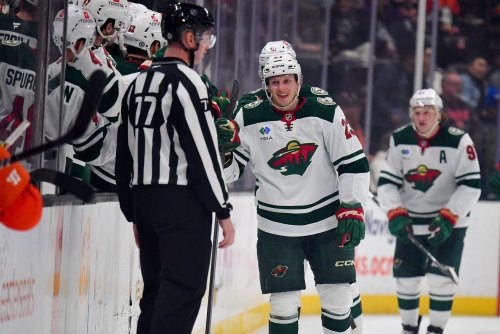
There's widespread concern about the Minnesota Wild’s lack of size this season. Only two of the six Wild defensemen, for example, are taller than 6'2" -- Jon Merrill and Jake Middleton. Minnesota's size discrepancy seemed to even have GM Bill Guerin wavering on 5'11" Calen Addison into the season, to the point where 6'8" veteran Andrej Sustr was getting serious consideration in camp.
Never mind that Addison has been the biggest upgrade to the Wild’s once-stale power play. Through eight games, Addison has five power-play assists and leads the team in overall assists. His quick, decisive play at the point keeps the puck moving to Minnesota's playmakers. It’s a big reason the Wild have the third-ranked power play in the league heading into Sunday’s game against the Chicago Blackhawks. His lack of punishing size doesn’t seem to hinder him while making plays that lead to winning hockey.
This is especially noticeable on defensive zone puck retrievals and zone entries. Per Corey Sznajder's All Three Zones project, Addison has been regularly efficient in puck retrievals and zone exits. In the four games Sznajder has been able to track, Addison has a 91.7% success rate on puck retrievals. That’s second among Wild defensemen behind Jared Spurgeon.
That trend continues for denying the opposition easy entry into the zone. Teams have targeted Spurgeon and Addison the fewest times as they attempt to gain entry into the Wild zone. These are two of the smallest players on the roster, standing at 5'9" and 5'11". Size be damned, right? Not necessarily, as evidenced by the 2-1 loss to the Detroit Red Wings. Steve Yzerman has put together a big, heavy roster that collapsed around their net effectively. Minnesota struggled to reach loose pucks that goalie Ville Husso failed to control. It didn't help that the Wild's bigger players aren't playing big.
“We don’t get opportunities by being a cute hockey team,” head coach Dean Evason said postgame. “We’re grit with skill, and we thought we were just skill tonight.” Looking back at the tape shows Wild players spent all game avoiding contact or waiting for the Red Wings to initiate it. Rather than playing the body, they tried to use their sticks and typically lost the one-on-one battles.
Middleton was one of the biggest offenders in that game. In the second period, he was called for tripping minor, a classic penalty for a player avoiding playing the body by playing the stick instead. That play started by Middleton losing the battle for the loose puck behind the Wild net. The puck fluttered behind the net, where Middleton tried to establish body position on Joe Veleno to play the puck. Not only did he not play the puck, Veleno out-muscled the 6'3" Middleton to get the puck away from the Wild defenseman. Last year’s trade deadline target couldn’t recover and tangled his stick into Veleno’s skates for the call.
That was just one instance. Middleton also forced a bad pass near the Wild blue line, creating a scoring chance for the Red Wings. If not for the goalpost, it would’ve gone down in the history books a la “Stoner To Hossa.”
This isn’t just to pick on Middleton, either. Merrill was also guilty of failing to use his body. Instead, in the middle of the second period, he went for a ride around the net that required a great save by Filip Gustavsson. In this play, he takes a bad angle and cannot knock Elmer Soderblom off the puck.
The lack of physicality carried over against the Seattle Kraken. Dave Hakstol’s team boxed out Wild forwards, intercepted every pass, and made the path to the net a living nightmare. Why couldn’t Minnesota mount a sustained offensive attack? Because they were not willing to engage. Meanwhile, smaller players like Kaprizov and Mason Shaw were the ones seeing absorbing hits and attempting to make things happen.
The reality is that if the Wild’s biggest players won’t, or worse, can’t, affect the game with their size, then any concern about diminutive players is misplaced. Minnesota didn’t have that problem last season or at least found ways around it by using speed, elusiveness, and quick puck movement. Playing gritty with skill might be the identity the Wild aspires to have. But until it’s more than a couple of smaller, scrappy forwards engaging in the play, that identity is more of a lofty goal. As players return to the lineup, they need to give their biggest players the same advice Goose gave Maverick in "Top Gun": re-engage into the fight.
Think you could write a story like this? Hockey Wilderness wants you to develop your voice, find an audience, and we'll pay you to do it. Just fill out this form.






Recommended Comments
There are no comments to display.
Join the conversation
You can post now and register later. If you have an account, sign in now to post with your account.
Note: Your post will require moderator approval before it will be visible.